By Jeffrey A. Rendall, Images courtesy of Leupold
BEAVERTON, OR – When you think about it, golf is very similar to hunting. In both endeavors, you’re identifying a target, selecting a “weapon” and taking a shot.
Golf is a bit less bloody, but a “hit” feels just as satisfying.
In order to excel at either sport, you’ll need proper visual guidance – and that’s where Leupold Rangefinders enter the picture. Leupold & Stevens was founded in 1907 and has been manufacturing precision optical instruments and other products ever since.
The company’s website says it’s a fifth generation family-owned business committed to building the best optics for shooting sports, general and wildlife observation, and the military and law enforcement communities.
What about golf?
According to Eric Overstreet, Leupold Technology Brand Manager, Leupold entered the golf market in 2007. “After making rangefinders for the hunting community for almost a decade earlier, branching over to golf was a natural step for our laser products.”
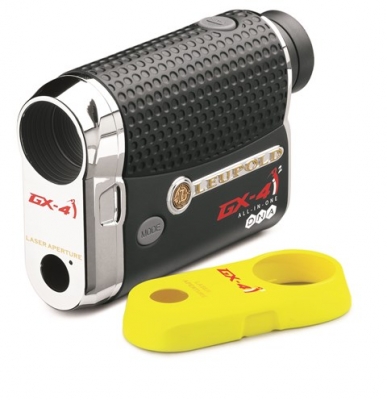 |
He continues, “Our in-house development team of engineers allows marketing and engineering to spend time together in the field evaluating different algorithms and features to ensure we provide the best features and solutions. Leupold had significant awareness in the golf community through its legacy of hunting products and made for a smooth transition within the first couple years.”
Smooth indeed. Do a search for golf rangefinders and Leupold pops up right alongside some more familiar names. Not bad for a group that’s only been in the golf rangefinder business for seven years.
We’ll add some of our own impressions of the Leupold GX-4i2 below, but for now, we thought a general introduction to the company and rangefinders in general would be in order. Eric Overstreet serves as our guide:
GolfTheUnitedStates.com: Some players prefer GPS units in obtaining distance readings on the golf course. Why would you say rangefinders are superior?
Overstreet: GPS units have been preferred by the casual golfer where rangefinders have been the choice for golfers with lower handicaps where accuracy is more important. Leupold lasers are accurate to the pin within .5 yard, where GPS has many factors that make it a “guess” to the pin.
First, the “positional” error for the GPS unit can be +/- 5 yards or more depending on signal quality and the distance to the flag is measured by distance to front/middle/back of the green. This means users need to guess where the pin is positioned on the green in relation to the front or back of the green.
Secondly, laser RFs have a lower cost of ownership after purchase. Where somebody who uses it twice on every hole and plays 3 times a week can expect to change their battery once a year, GPS users need to buy/download courses every time they play somewhere new. As courses change or temporary winter greens are put into place (common here in the northwest), users need to pay to have their course updated or cannot use the tool at all in the case of temporary greens. Third, GPS units don’t tell you the distance to carry the water/sand trap, or where the dogleg starts.
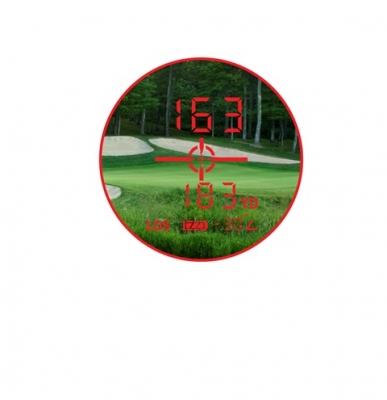 |
Lastly, GPS users need to pull their unit (or watch) out of their bag to recharge it after each use and remember to put it back in their bag before heading out to the course again. The big objection GPS users have had to rangefinders is the ability to hold the rangefinder on the flag to get the correct distance (rather than a tree behind the flag). Meeting with customers who have this objection, they can easily be coached to use “correct” rangefinding techniques to be converted to laser users.
Further, Leupold’s PinHunter 2 and Prism lock ensure a high user confidence that they are able to range the flag quickly and easily.
GolfTheUnitedStates.com: All true. I have often forgotten to recharge my GPS unit…
There are a number of competing brands for rangefinders... what makes Leupold better than the competition?
Overstreet: Leupold has many proprietary features that elevate the GX-4i2 above the competitors.
1) Removable faceplate - Working closely with the USGA for over 5 years earned the GX-4i2 a unique differentiator of being the only rangefinder that can be used as a training aid or for tournament play when USGA local rule 14-3 is in effect (with the chrome faceplate attached).
The algorithms for the TGR (True Golf Range) are located in the yellow faceplate -- and when removed, so is the capability to provide adjusted distance for uphill, downhill or atmospheric conditions. Leupold has a patent on this “removable faceplate” technology.
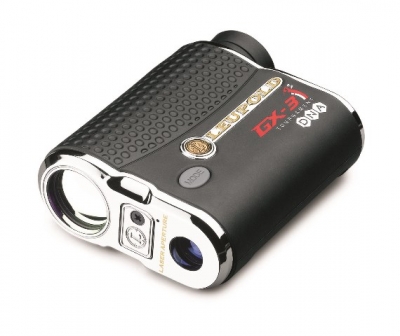 |
2) Prism Lock – When the Leupold rangefinder is used on a course with prisms, the unit will automatically lock onto the prism giving the user the confidence they have hit the pin. Where other manufacturers who use prisms can only find the distance to a prism, the Leupold rangefinder can also be used for any target on the course – sand trap, trees, water, dogleg, etc.
Bushnell’s response to our prism lock was “jolt” technology. It is advertised as vibrating when the unit hits the pin. In reality, the unit will vibrate whenever it finds more than 1 target. So if you range the pin and miss, the rangefinder will still “jolt” as the trees behind the pin will provide multiple target distances.
With Leupold, you know you’ve hit the flag.
3) PinHunter 2 – The GX-4i2 and GX-3i2 (Line of Site only sister unit) was the first unit to feature PinHunter 2. When a user is scanning for the flag, the rangefinder is doing an awful lot of work behind the scenes to ensure the flag is ranged and not the trees behind the flag.
4) TGR – True Golf Range allows users to customize the rangefinder for their own hitting ability when hitting uphill or downhill. In the picture below, you can see that 2 different players with 2 different hitting abilities make the same shot (player A hits for 170 yards while player B hits for 163 yards).
The Leupold user can use the default “average” or enter in their own hitting strengths. Then, the Leupold rangefinder customizes the player’s trajectory to provide them the exact distance for their own hitting ability. Where competitor “B” provides an average distance to the green, you can see there is likely +/- 1 club length between the 2 different manufacturers.
5) Atmospherics – Within TGR, the user can enter data for changes in elevation and temperature. For example, a player whose home course is in Florida at sea level might hit a 6 iron 170 yards. When that player travels to Colorado or Lake Tahoe on vacation, however, their ball will play longer. Leupold’s TGR allows them to enter the elevation where they are playing and adjust the ball playing longer at higher altitudes.
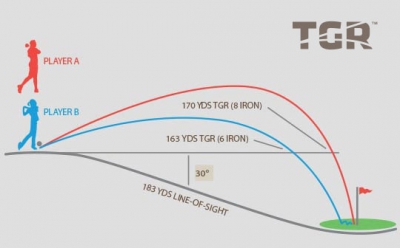 |
GolfTheUnitedStates.com: That’s a neat tool, for sure. Please describe how the GX-4i2 is different from your past products, and how it's improved. Also, how long will the battery last?
Overstreet: The GX-4i2 has been improved on a number of fronts from its earlier GX-4i model:
1) PinHunter 2 – We made adjustments within the algorithm to perform a lot more “monitoring and analysis” behind the scenes when a golfer scans for the pin. This will speed up the time it takes for a golfer to “get on the flag.”
2) Prism Lock – We updated prism lock algorithms so that it would lock on the flag much faster than previous models.
3) “Conforming” removable faceplate – This is the first unit the USGA has ruled conforming when USGA local rule 14-3 is in effect. Where previous models performed a functional check (is the smart key – the yellow faceplate – present or not?) the GX-4i2 stores the TGR algorithms in the front faceplate so when the smart key is removed, the capability to perform TGR is removed.
4) Battery life – The battery will last around 1 year for a user who plays 3 rounds a week and uses it twice on every hole.
GolfTheUnitedStates.com: Do the True Golf Range and Club selector features need to be reprogrammed every time, or is the data saved?
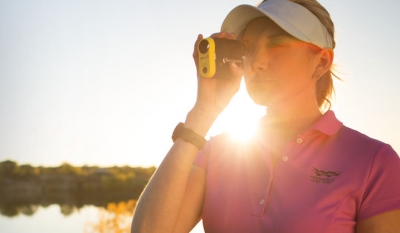 |
Overstreet: The data is saved. Even when the battery is removed, the rangefinder will remember what had been programed.
GolfTheUnitedStates.com: What's the best argument for allowing all the features of the GX-4i2 to be used in competition?
Overstreet: The USGA is coming under pressure to revive the game golf. One of the most common complaints is “pace of play.” The GX-4i2 with the chrome face plate is allowed now -- with a recent ruling to be used during amateur tournaments.
I can see a future where the TGR capabilities could be allowed in an effort to speed the game up further. This information could all be logged ahead of play by course mapping. Allowing the use of the rangefinder on the course would provide an additional boost in speed when analyzing how to adjust for the uphill/downhill component.
GolfTheUnitedStates.com: Do you foresee a day when these types of devices will replace the need for caddies?
Overstreet: I think the function of these devices could replace a portion of the guidance provided by caddies, but I believe the game of golf, which is very set in its traditional ways, will always have a place for caddies on the PGA Tour and when playing at higher-end courses.
______________________________________________________________________________
Caddies will certainly remain part of golf, and I’m sure all makers of rangefinders and GPS devices would agree that their products are not intended to replace the human element.
But much of what Overstreet mentioned is also true – golf needs to speed up. We found that the GX-4i2 definitely helped towards that purpose. Simply put, it’s a “neat” tool. Drive or walk to your ball, grab the rangefinder, scope out your target and get the yardage. No more searching for sprinkler heads, and no more wondering whether the GPS on the cart is correct or not.
 |
| Tobacco Road Golf Club in North Carolina provides an excellent example of how rangefinders can be useful. |
The rangefinder does get some getting used to – and it is somewhat challenging to hold it steady enough to home in on your target instead of the background.
But not that hard. Courses that don’t have prisms on the flags can be frustrating at times. Scoping out bunkers and other features was very easy, including swales on greens.
We didn’t have an opportunity to check out the True Golf Range features in great depth, but we can see where they would be helpful if fully implemented. It will take some time to program them into the device, but it is worth it.
We look at the TGR features as kind of a “second opinion,” similar to what a caddy might offer. It suggests clubs, for instance, but you’ll also have your intuition as a guide to the distance and type of shot you want to play.
No electronic device will ever replace knowledge of your own golf game, and that’s a good thing.
The quality of the Leupold devices shines through, and we highly recommend you take a look at them if you’re in the market for a distance measuring tool.
It’s one sure way to hit your target every time.
Details:
Leupold & Stevens
14400 NW Greenbrier Parkway
Beaverton, OR 97006-5790 USA
Phone: 1-800-LEUPOLD
Website: http://golf.leupold.com/
| Related Links | Comments on this article? | |
|
Maryland National Golf Club Hollow Creek Golf Club Rocky Gap Resort PB Dye Golf Club in Ijamsville Whiskey Creek Golf Club |
E-mail Jeff Rendall, Editor: jrendall@golftheunitedstates.com |












